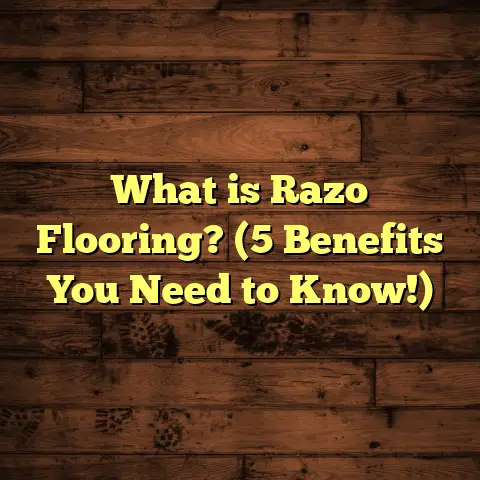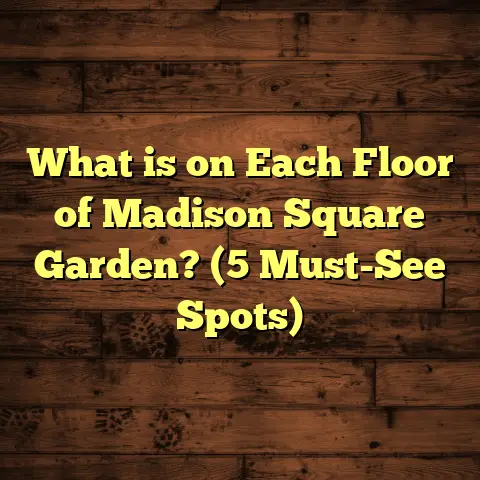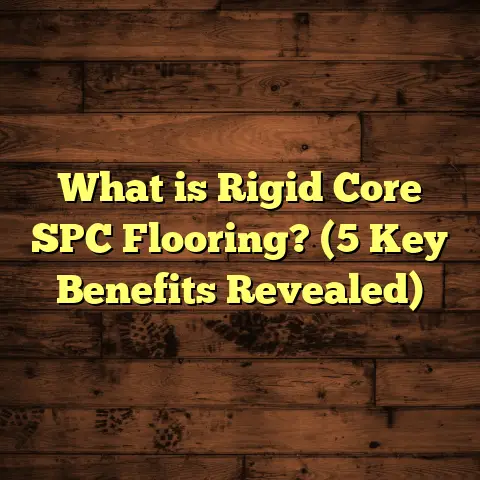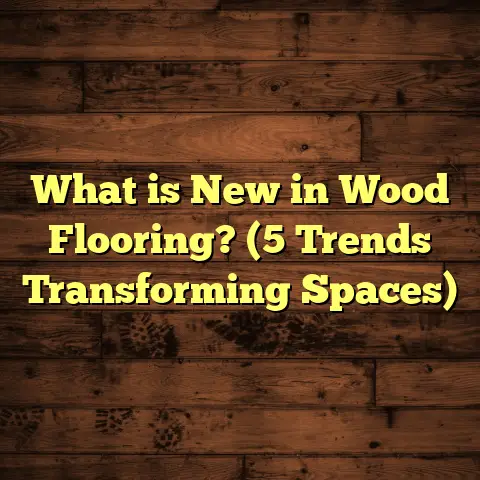What is More Expensive: Carpet or Laminate Flooring? (5 Key Cost Factors)
I once met a young couple who just bought their first house, excited to make it their own. They were
staring at two large boxes in their empty living room—one labeled “Carpet Samples,” the other “Laminate
Flooring Planks.” They were stuck, torn between comfort and durability, softness and sleek style, and
most importantly, the cost. They asked me, “What’s going to cost us more over time—carpet or laminate?”
I had helped countless homeowners with this exact question, and their hesitation reminded me how
often this choice isn’t just about price but about lifestyle and long-term value.
If you’re wondering the same thing, you’re not alone. Flooring is one of those big home expenses that
can feel overwhelming because there’s more than just a price tag involved. Materials, installation,
maintenance, lifespan, and even resale value all play a role—and I want to share what I’ve learned
over my years in the flooring business to help you make a smart decision.
What is More Expensive: Carpet or Laminate Flooring? (5 Key Cost Factors)
Before diving into the numbers, let’s break down exactly what we mean by carpet and laminate flooring,
and why they’re so different in cost and care.
What Exactly Is Carpet?
Carpet is a textile floor covering made by weaving or tufting fibers such as wool, nylon, polyester, or olefin.
It’s praised for its softness, warmth, and noise-dampening properties. You can find carpets in a huge range
of styles—from plush shag to low-pile loop—and in nearly every color imaginable.
Carpet fibers vary in durability and feel. For example:
- Nylon: Durable and stain-resistant, often used in high-traffic areas.
- Polyester: Soft with vibrant colors but less durable.
- Wool: Luxurious and naturally stain-resistant but expensive.
The backing of the carpet and padding underneath also impact comfort and longevity.
What Is Laminate Flooring?
Laminate flooring is a type of multi-layer synthetic flooring product fused together with a lamination process.
It simulates wood (sometimes stone or tile) with a photographic image layer protected by a clear wear layer.
Underneath is high-density fiberboard (HDF) or medium-density fiberboard (MDF).
Laminate is popular because it offers the look of hardwood at a fraction of the price and is relatively easy to install.
It’s scratch-resistant, easy to clean, and comes in a variety of finishes and plank sizes.
1. Initial Material Cost: What Are You Paying For?
When I help customers pick flooring materials, the price per square foot is always one of the first things they ask about.
Carpet Cost Breakdown
Carpet prices depend heavily on fiber type, pile height, density, and brand.
- Budget carpet: Around $1-$2 per sq.ft.
- Mid-range carpet: $3-$7 per sq.ft.
- High-end carpet (wool or specialty fibers): $8-$15+ per sq.ft.
For example, nylon carpets are usually mid-range and popular for durability. Wool carpets run high because they are natural and luxurious.
Laminate Cost Breakdown
Laminate pricing depends on thickness, wear layer quality, design realism, and brand.
- Budget laminate: $0.99-$2 per sq.ft.
- Mid-range laminate: $2-$5 per sq.ft.
- High-end laminate: $5-$10 per sq.ft.
Thicker laminates with higher abrasion ratings (AC4-AC5) cost more but last longer in busy spaces.
Real-Life Example
One of my clients wanted affordable carpet for their basement — they found a nylon option for $3/sq.ft.
Another client wanted a rustic wood look with laminate and chose a mid-range product at $4/sq.ft.
So for a 600 sq.ft room:
- Carpet material cost = $3 x 600 = $1,800
- Laminate material cost = $4 x 600 = $2,400
That’s a $600 difference upfront just on materials.
2. Installation Costs: How Much Will It Cost to Put Down Your Floor?
Installation often surprises people because it can be as much as or more than the material cost.
Carpet Installation
Carpet installation typically involves:
- Laying down carpet padding (which adds comfort and extends carpet life)
- Stretching carpet onto tack strips around the room
- Seaming multiple carpet rolls together if necessary
Labor costs range from $1 to $3 per square foot depending on your region and complexity.
For example:
- Basic installation = $1.50/sq.ft.
- Adding premium padding = extra $0.50/sq.ft.
Laminate Installation
Laminate installation is more complex:
- You need an underlayment (foam or cork) for cushioning and moisture protection
- Planks click-lock together tightly
- Careful cutting around corners and thresholds
Labor costs tend to be higher:
- Average installation = $2 to $5 per sq.ft.
- Some installers charge extra for stairs or complicated rooms
My Experience on Installation Cost
In one project with a 700 sq.ft living room:
- Carpet installation cost was about $1.80/sq.ft. = $1,260
- Laminate installation was around $3.50/sq.ft. = $2,450
Though laminate seemed pricier upfront, its durability made it worth considering.
3. Maintenance & Lifecycle Costs: What Happens After Installation?
You might not think about this at first, but maintenance costs can add up over years or decades.
Carpet Maintenance
Carpet requires:
- Regular vacuuming (mostly DIY)
- Professional steam cleaning every 12-18 months ($100-$300)
- Spot treatments for stains
Carpets have a shorter lifespan — usually 7-10 years before you want to replace them due to wear or discoloration.
If you have pets or kids, expect stains and odors that may require more frequent cleaning.
Laminate Maintenance
Laminate floors are easy to maintain:
- Sweep or vacuum regularly to remove dirt
- Damp mop occasionally with laminate-safe cleaner
- Avoid standing water (can cause swelling)
Laminate floors last longer — 15-25 years if cared for properly.
Repairs are tricky though—damaged planks often need replacing individually or in sections.
Cost Over Time Example
Let’s revisit that 600 sq.ft room with carpet costing $3/sq.ft. + $1.50/sq.ft installation = $2,700 total upfront.
Add cleaning costs every few years ($200 average) plus replacement after 10 years ($2,700 again).
Over 15 years:
- Carpet total = $2,700 (initial) + $600 (cleanings) + $2,700 (replacement) = $6,000
Laminate cost was higher upfront at approx $4,800 installed but minimal cleaning costs ($50/year) + no replacement needed yet.
Over 15 years:
- Laminate total = $4,800 + $750 (cleaning) = $5,550
This simple example shows how laminate can be cheaper long-term despite higher start-up costs.
4. Durability & Wear Resistance: Which Floor Can Take More?
Durability heavily influences how often you’ll replace or repair your flooring—impacting your wallet big time.
Carpet Durability
Carpet fibers wear down with foot traffic causing matting or bald spots. Nylon is among the toughest fibers but still won’t match hard surfaces under heavy use.
Stains are another issue—unless treated with stain protection during manufacturing or install, liquids soak in fast.
Pets scratching or accidents can damage carpet backing too.
Laminate Durability
Laminate floors resist scratches better thanks to their tough wear layer rated by AC scale:
- AC3: Residential moderate traffic
- AC4: Residential heavy traffic/commercial light traffic
- AC5: Commercial heavy traffic
Water damage is laminate’s Achilles heel; spills must be cleaned promptly or planks may swell permanently.
I’ve installed laminate in family homes with kids and dogs where carpets wore out fast but laminate still looked new after years.
5. Aesthetic Appeal & Impact on Home Value
Aesthetic preference plays a big role in your choice—and it can affect your home’s resale value too.
Carpet Looks & Feel
Carpet creates cozy rooms with warmth underfoot—great for bedrooms or media rooms where noise reduction matters.
However, some buyers see wall-to-wall carpet as outdated or less desirable compared to hard floors.
Laminate Looks & Feel
Laminate mimics hardwood at lower costs and maintenance hassles. It brightens spaces and can make rooms feel larger thanks to reflective surfaces.
In many housing markets today, homes with wood-look floors sell faster and sometimes at higher prices than those with mostly carpeted floors.
According to a recent study by Remodeling Magazine:
- Wood/laminate flooring can increase home resale value by up to 5%
- Carpeted homes see less resale premium unless carpet is very high quality
Personal Stories That Bring These Points to Life
One time I worked with an elderly couple who wanted carpet in their living room because they preferred the softness underfoot.
They valued comfort above all else despite some staining risks from their cat. We chose a plush nylon carpet with stain-resistant treatment at a moderate price point. They were happy for 8 years until it needed replacing—but loved the comfort while it lasted.
Contrast that with my friend who recently installed laminate in his kid-heavy household because he was tired of constant carpet stains and smell issues. After four years, his laminate looks nearly brand-new despite spills and rough use from kids’ toys. He says it’s worth every penny upfront knowing it will last longer.
Detailed Data & Stats You Can Trust
| Factor | Carpet | Laminate |
|---|---|---|
| Average Material Cost/sq.ft | $3 – $7 | $1 – $5 |
| Average Installation Cost/sq.ft | $1 – $3 | $2 – $5 |
| Lifespan | 7 – 10 years | 15 – 25 years |
| Maintenance Cost/year | ~$150 (cleaning) | ~$50 (cleaning) |
| Durability | Moderate | High (scratch-resistant) |
| Water Resistance | Poor | Moderate (no standing water) |
| Resale Value Impact | Low to Moderate | Moderate to High |
How To Calculate Your Own Flooring Costs Easily
If you want to get precise estimates tailored to your location and project size, I recommend using online tools like FloorTally. I’ve used it several times myself when quoting jobs because it incorporates:
- Realistic local labor rates
- Material waste factors (usually 5%-10%)
- Variety of materials and styles
- Easy-to-use interface for both DIYers and pros
It saved me hours compared to calling multiple suppliers for quotes—and helped clients budget confidently without surprises later on.
Common Myths About Carpet vs Laminate Costs Debunked
Myth #1: “Carpet is always cheaper than laminate.”
Truth: While carpet often costs less initially, laminate’s durability can make it more economical over the years.
Myth #2: “Laminate floors are cold and uncomfortable compared to carpet.”
Truth: With good underlayment, laminate can feel warm underfoot; plus area rugs add comfort easily.
Myth #3: “Carpet doesn’t need much maintenance.”
Truth: Carpets require regular vacuuming plus professional cleanings; neglect leads to odors and early replacement needs.
Questions I Often Get Asked About Carpet vs Laminate Pricing
Q: Is laminate harder to install than carpet?
A: Yes—laminate requires precise plank alignment plus underlayment prep which usually means higher labor costs.
Q: Can I install laminate myself?
A: Many DIYers do because of click-lock systems; however proper subfloor prep is key for success.
Q: Which flooring is better for homes with pets?
A: Laminate resists scratches better but moisture damage from accidents is a concern; carpets trap odors unless cleaned well.
Wrapping Up My Thoughts — What Should You Choose?
Deciding between carpet and laminate depends largely on your lifestyle priorities:
- Want softness & warmth? Carpet might be better.
- Want durability & easier upkeep? Laminate could save money long-term.
- Have kids/pets? Consider wear resistance carefully.
- Planning to sell soon? Laminate often boosts resale appeal.
From my experience working on hundreds of projects over two decades, laminate tends to be more expensive initially but pays off over time through durability and lower maintenance costs. Carpet wins on comfort but often needs replacing sooner—making total cost higher long-term if you’re not ready for that cycle.
I hope this gives you a clearer picture of what you’re getting into with each option! If you want help calculating exact numbers based on your home size and style preferences—or figuring out which materials fit your budget—I’m happy to guide you through it anytime. Just ask!
What kind of flooring do you like best? Have any personal stories about floors you loved or hated? I’d love to hear what flooring means to you!
If you’d like me to add specific case studies based on your region or explore eco-friendly options within these flooring types next, just say so!





